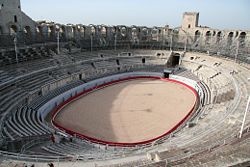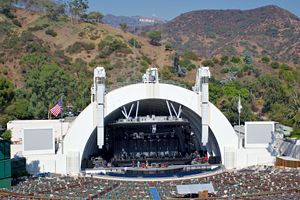Amphitheatre

An amphitheatre (alternatively amphitheater) is an open-air venue for spectator sports, concerts, rallies, or theatrical performances. There are two similar, but distinct types of amphitheatres: Ancient amphitheatres, built by the ancient Romans, were large central performance spaces surrounded by ascending seating, and were commonly used for spectator sports; these compare more closely to modern open-air stadia. Modern amphitheatres, are more typically used for theatrical or concert performances and typically feature a more theatrical-style stage with audience only on one side, usually at an arc of less than a semi-circle; these compare more closely to the theatres of ancient Greece, and have been more commonly built throughout history as performance spaces. Amphitheatres are typically man-made, though there are also geological formations used in the same manner which are known as natural amphitheatres.
The term derives from the ancient Greek amphi-, meaning "around", or "on both sides" and théātron, meaning "place for viewing".[1]
Contents |
Roman amphitheatres
There are many famous examples from the Roman Classical period. Being particularly associated with ancient Rome, amphitheatres were used for various types of public spectacles. In the Roman Empire, amphitheatres were round or oval in shape (created originally from two wooden theatres joined together, hence the name "amphi"-theatre), forming a complete circle or ellipse, and were used for spectator sports, games and displays.
This is in contrast to a Greek or Roman classical theatre, which was semi-circular and used for theatrical performances (but also for gladiators in areas where amphitheatres were not available). An amphitheatre also differed from a Roman circus or Greek hippodrome, both of which were used for chariot racing and horse racing and were shaped more like a very long, narrow horse shoe. The best-known amphitheatre in the world is the Colosseum in Rome, which is more correctly termed the Flavian amphitheatre (Amphitheatrum Flavii), after the Flavian dynasty who had it built. An amphitheatre in a community became a prized symbol of Roman citizenship in the outlying areas of Italy. In the small town of Larino, in the Molise, a man who had made his fortune in far away Rome financed the construction of an oval amphitheatre that could house ten thousand spectators. In fact, the amphitheatre in Larino predates the Colosseum. The remains of some 230 amphitheatres have been located in widely scattered areas of the Roman Empire. (See:List of Roman amphitheatres)
Contemporary amphitheatres

A contemporary amphitheatre is a curved, acoustically vibrant performance space, particularly one located outdoors. Contemporary amphitheatres often include standing structures, sometimes curved or "bowl" shaped, both behind the stage and behind the audience, creating an area which echoes or amplifies sound, making the amphitheatre ideal for musical or theatrical performances. Most are semi-circular in shape, and so should not properly be called amphitheatres. Notable modern amphitheatres include the Gibson Amphitheatre and the Hollywood Bowl; the largest amphitheatre in North America is the Hyundai Pavilion in Devore, California, with a seating capacity of 65,000.
Natural amphitheatres

A natural amphitheatre is a performance space located in a spot where a steep mountain or a particular rock formation naturally amplifies or echoes sound, making it ideal for musical and theatrical performances. The term amphitheatre can also be used to describe naturally occurring formations which would be ideal for this purpose, even if no theatre has been constructed there. Notable natural amphitheatres include the Drakensberg amphitheatre in Drakensberg, South Africa, Slane Castle in Ireland, Echo amphitheatre, Red Rocks Amphitheatre and The Gorge Amphitheatre, all of which are in the United States.
Gallery
Note
- ↑ Hoad, T.F. (1996). The Concise Oxford Dictionary of English Etymology. Oxford University Press. pp. pp. 14, 489. ISBN 0-19-283098-8.
See also
- Arena
- Ludus Magnus
- Stadium
- Thingplatz
- List of Roman amphitheatres
- List of contemporary amphitheatres
- List of indoor arenas
External links
- article "Amphitheatrum" (Smith's Dictionary of Greek and Roman Antiquities)
- Caerleon amphitheatre
- Chester amphitheatre
- Pula amphitheatre
- Rome: Colosseum at LacusCurtius with Platner article
- Rome: Amphitheatrum Castrense
- France : Nimes Antique Arena
- Photos about Roman ruins in Budapest